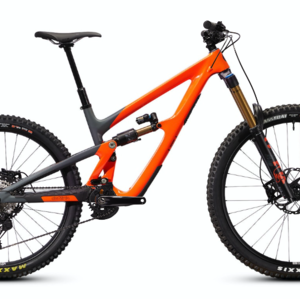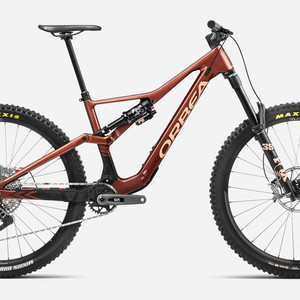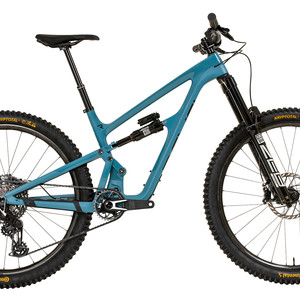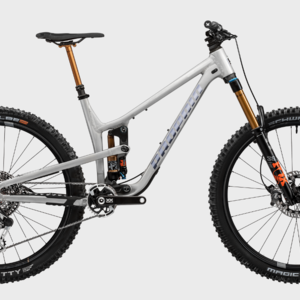2015 Cannondale Jekyll 27.5 Carbon Team
(discontinued)
| Where To Buy | |||
|---|---|---|---|
Free U.S. shipping on orders over $45.
International shipping available. Some exclusions apply. |
|||
Free shipping on orders over $50 (continental U.S. only).
International shipping available. Some exclusions apply. |
|||
Free standard shipping on orders of $50 or more (U.S. only).
International shipping available. Free on orders of $150 or more. Some exclusions apply. |
|||
Free shipping on orders over $50 (continental U.S. only).
International shipping available. Some exclusions apply. |
|||
Reviewed by Dylan Stucki and AJ Barlas // Photos by Lear Miller
After taking a win at the notoriously rough Mammoth ProGRT downhill course under Marco Osborne, the new Cannondale Jekyll is proving to be a head turner with a complete geometry revamp, updated rear shock tune, 27.5-inch wheels, more travel, and the unique carbon Lefty SuperMax PBR fork. Do the revisions add up to a better Jekyll? We hit the trails during the 2015 Vital MTB Test Sessions to find out.

Highlights
- Carbon frame
- 27.5-inch wheels
- 95mm or 160mm (3.74 or 6.3-inches) of rear wheel travel // 160mm (6.3-inches) front travel
- 1.5 Si head tube
- 67-degree head angle
- 75.1-degree (S), 74.9-degree (M), 74.8-degree (L), 74.7-degree (XL, tested) effective seat tube angle
- 351mm (13.8-inch) measured bottom bracket height
- 440mm (17.3-inch) chainstays
- BB30 PressFit bottom bracket
- 142mm rear spacing with 12mm through axle
- Measured complete weight (size XL, no pedals): 28-pounds, 3-oz (12.8kg)
- $7,580 MSRP
The most notable update to the Jekyll for 2015 is the geometry. Heavily influenced by the first ever Enduro World Champion, Jerome Clementz, the Jekyll gets a longer top tube, slacker head angle, and steeper seat angle.

Cannondale keeps the pull-style, dual-position FOX DYAD RT2 shock for 2015. It features a Jekyll-specific tune to provide a "plusher ride" than in years past, including a redesigned piston to enable better oil flow for improved mid-to-high speed compression damping. The shock can be changed from 160mm to 95mm travel with the flip of a handlebar switch. To really envision what's going on, it's best to think of the DYAD RT2 as two separate shocks combined into one. Depending on the handlebar remote setting, the oil displaced by the center pull chamber will go into one or both sides.

In "Flow" mode the bike gets the full 160mm of travel and utilizes both positive air chambers and its own damping circuit. Doing so yields a high-volume air shock and more linear feel.
In "Elevate" mode the bike gets just 95mm of travel. This occurs because the shock is trying to pump all of the available oil into just one chamber and there simply isn't enough volume. As a result the sag point changes and the spring rate becomes more progressive. This steepens the bike's sagged head and seat tube angles, picks the bottom bracket up a bit, and provides a firmer pedaling platform.
The two modes have different compression and rebound damping characteristics. Setup is a bit more involved than a traditional air shock due to the adjustable positive and negative air springs, separate low-speed rebound adjustment for each travel setting, and the need for a special high-pressure pump. High-speed rebound and compression are factory-tuned.
Out back, the swingarm and linkage are secured with large 15mm thru-axles combined with widely spaced bearings and a collet sleeve bearing preload system. The lower pivot axle is clamped by bolts on both sides. Finally, they double-stack bearings in each rear pivot to increase resistance to twisting loads.

The new 160mm travel Lefty SuperMax 2.0 PBR fork is a surprisingly stout addition to the lineup. The unique dual-crown, single-leg inverted design features a 36mm stanchion, oversized 46mm carbon chassis, 1.5-inch steerer, Push Button platform lockout, and integrated crowns and bump stop. The hidden top portion of the stanchion is square-shaped, which prevents the two tubes from rotating relative to each other and is key to retaining torsional stiffness. The stanchion slides on four sets of needle bearings rather than bushings, reportedly reducing stiction when loaded. This design requires a proprietary hub and tapered axle. Seeking a bike that could provide stability at high speeds but also handle as well as one with steeper angles at lower speeds, they chose to kick the head angle out a degree and increase the fork’s offset measurement to 50mm from the typical 42-45mm. Internally, the fork also sees a new piston to increase oil flow for better small bump and high-speed performance. Low-speed compression damping is unchanged from the prior model.
Cable routing is mostly external, with the derailleur, brake, and dropper post housing following the underside of the downtube - a path vulnerable to rock strikes. The RockShox Reverb Stealth dropper post goes into the base of the seat tube, and the rear shock cable routes internally through the side of the headtube. The cables and frame are protected around the bottom bracket area, but never say never. Additional frame guards include a rubber chainstay pad and metal guard to prevent damage from dropped chains.
Additional features include the option for a direct mount front derailleur, ISCG03 tabs for those wanting a chainguide, press fit BB30 bottom bracket, room for a water bottle in the front triangle, and ~12mm of mud clearance around the stock 2.35-inch Schwalbe rear tire.
The Jekyll 27.5 is offered in two carbon models priced at $6,170 and $7,580, as well as two aluminum models at $3,250 and $3,900. Want just the carbon frame and shock? That'll run you $3,500. We tested the top-tier Carbon Team model.
On The Trail
We rode the Jekyll in a variety of terrain in the mountains surrounding San Luis Obispo, California, ranging from wide open speed fests to loose, unpredictable chunk and rocky switchbacks.

Initial setup was relatively straightforward, but required a bit more attention than normal due to the unique suspension. The shock's setup chart is stickered on the frame and there are two sag meters which help speed things up. With suggested pressures over 300psi for most riders, you'll definitely need the supplied high-pressure pump for adjustments, so don't leave home without it. The Lefty was a bit more mysterious in terms of setup, but after a few on-the-trail adjustments to the air pressure we were good to go.
Cannondale's choice in cockpit components has improved for 2015 with a 50mm long FSA Gravity Light stem, but the 740mm wide Cannondale C1 Carbon bars are still too narrow for many riders. At 6'3" and 6'5" tall, we preferred an 800mm wide bar on our size XL test bike.
The old Jekyll had a 68-degree head tube angle and a suggested rear sag point of 40%, while the new Jekyll sits at 67-degrees and rear sag is just 30% - making the angles close to equivalent while on the trail. Even so, compared to the previous model, the added length in the top tube, chainstay, and slacker head angle combined made the Jekyll more stable on high-speed, wide open sections. We found the 484mm reach and 650mm effective top tube length very accommodating to our height, which is much less common than us tall guys would hope. The longer wheelbase helped keep the bike planted, rather than accentuating playfulness like the older model did well.
The new bike's head angle is still a degree or two steeper than many other 160mm enduro bikes, which shows Cannondale's priority towards an agile ride while still granting some composure when things get steep, though not as much as the most aggressive class leaders. Combined with the increased fork offset, the bike was very manageable as things slowed down, and we were able to maintain balance and navigate tight switchbacks well.

While handling was quick and precise, it took a little longer to inspire confidence than comparable bikes and didn’t seem to hold traction super well. The suspension felt stiff at the recommended 30% sag point with more of a race setup than an everyday comfortable feel. Small bump compliance and rear wheel traction left something to be desired, though small air pressure adjustments improved the ride slightly. The single pivot design firms up under braking, which further accentuates things. The shock provides good bottom-out support combined with a slightly progressive leverage curve.
We found that the bike rides very high in its travel, and sometimes uncomfortably so at the suggested 30% sag. Though still relatively tall, when we measured the bottom bracket height it was 13mm lower than the claimed 364mm.
The Jekyll really showed its prowess over other enduro/all-mountain bikes on smooth ascents. It quickly transformed into an XC-esque machine with both suspension climbing features engaged, which was also excellent for sprinting. The bike relies heavily on the dual-mode shock in order to achieve this, though, as the suspension design provides only a mild pedal platform with little anti-squat when used with the stock 30-tooth chainring and 1X drivetrain. Turning the shock to the 95mm Elevate setting stiffened up the rear end a lot, which, depending on the terrain, also took away from climbing traction and comfort. It performed more like a lockout than a shorter travel option, and may be less preferable than the 160mm Flow mode on rough climbs. Those seeking a more pedal-friendly ride without the use of the suspension modes will be best off with a 2X drivetrain, as smaller chainrings provide more anti-squat on this design.
Changing travel modes may seem awkward at first until you realize how to best use the adjustment lever, and after that it becomes natural and surprisingly quick to do. Pushing with your thumb puts the bike in the shorter travel mode, and depressing the silver button at the end of lever returns it to the longer travel position. It’s easiest to rock your hand over and use the side of your pointer finger to return to the longer travel mode rather than once again reaching up with your thumb.
Build Kit
Aside from the out of place spoke guard and reflectors, the Jekyll Carbon Team features a build kit that's certainly in the upper-mid to high-range with a total weight of 28.2-pounds. Components include parts from Cannondale, WTB, DT Swiss, Schwalbe, Magura, SRAM, and RockShox.

Of particular interest was the SuperMax Lefty fork. Despite having only one leg, the fork was deceptively stiff on the trail, backing up Cannondale’s claims. On rocky descents the front end sometimes felt as though it was deflecting more than normal, but you could push into it with authority and the response was impressive. The Push Button climbing platform was also easy to use. While intriguing, we ultimately found it to be a bit less adjustable, supple, and active than some of the more popular traditional forks on the market.
The WTB Team Issue i23 rims took some abuse over the course of testing, but held their own with just a little wobble in the rear. The tubeless ready rims are paired with a DT Swiss 350 rear hub and Cannondale Lefty front hub.
Schwalbe's 2.35-inch Hans Dampf Snakeskin Trailstar tires provide lots of volume and good bite at a reasonable weight, though they do slow things down a bit in the rolling department. We've found that the corner knobs also tend to tear prematurely.
Magura's MT7 brakes with dual 180mm Storm SL rotors performed quite well, though hard charging riders may want a larger rotor up front for more power. Swapping controls to accommodate riders who prefer their brakes to be setup "euro style" can be a little awkward as the lines aren't long enough due to cable routing on the Lefty. Rearranging the cable guides provided just enough slack.
The drivetrain includes Cannondale HollowGram Si cranks with a 30-tooth SRAM XX1 chainring, XX1 derailleur and cassette. Those planning to race the bike will want to consider an upper chainguide for added security. Adding some mastic tape to the inside of the seatstay will also help silence chainslap completely.
Finally, the RockShox Reverb Stealth provided a quick and easy way to adjust seat height at a moment's notice. We'd like to see Cannondale use a lever mounted under the left side of the bar rather than on top of it for the best ergonomics.
Long Term Durability
Our primary durability concern is the use of a proprietary shock. The shock developed an odd "chirp" sound in the top of the travel, and rebound at the end of the stroke slowed down significantly as time went on. After starting the setup process over from the beginning, it was only a matter of a few hours before the issues resurfaced. Enduro and all-mountain bikes take a lot of abuse and wear, and our experience with the proprietary rear suspension made us feel as though the Jekyll could possibly be in the shop more often than other bikes. Replacement shock availability is also something to consider, especially in race scenarios.
Cannondale backs the frame with an impressive lifetime warranty.

What's The Bottom Line?
The 2015 Cannondale Jekyll 27.5 Carbon Team is a nice update to the previous model, and the changes result in a more planted ride at speed with better geometry. The build kit is pretty much race-ready, too. Smooth uphill and sprinting performance stood out in the special climbing mode, but when pointed downhill it often seemed to operate like a bike with 20mm less travel, sometimes riding uncomfortably high and lacking the supple suspension other bikes in its class offer. The bike's results under very skilled professional riders are nothing short of impressive, though, so clearly in the right hands it has potential for greatness.
Visit www.cannondale.com for more details.
Bonus Gallery: 20 photos of the 2015 Cannondale Jekyll Carbon Team up close and in action
About The Reviewers
Dylan Stucki - When he's not busy popping no-handed wheelies or shot-gunning beers you're likely to find Dylan comfortably inside the top ten at Big Mountain Enduro races. Since he's a big guy and charges hard he breaks a lot of stuff. He's naturally a perceptive and particular rider who picks up on even the smallest details.
AJ Barlas - In 15 years on the bike AJ has developed a smooth and fluid style. Hailing from Squamish, BC, his preferred terrain is chunky, twisty trail with natural features. He's picky with equipment and has built a strong understanding of what works well and why by riding a large number of different parts and bikes.

About Test Sessions
Three years ago Vital MTB set out to bring you the most honest, unbiased reviews you'll find anywhere. That tradition continues today as we ride 2015's most exciting trail, all-mountain, and enduro bikes in San Luis Obispo, California. Reviews can be accessed 24/7 in our Product Guide. Test Sessions was made possible with the help of Foothill Cyclery. Tester gear provided by Five Ten, Race Face, Easton, Troy Lee Designs, Club Ride, Kali, Royal, Smith, Pearl Izumi, and Source.
2 member reviews
Luckily I got this at a killer deal from my shop and the 2004 Jekyll was my first ever full suspension mountain bike, so I have a soft spot for the Cannondale Jekyll. Once I first got the bike, I realized that it handled very fast and accurately, it was super light (especially compared to my peers of Trek, and Rocky Mtn, Norco, etc), the geo just fit me perfectly and the front end was very easy to pull up for manuals and wheelies compared to my trek remedy.
After riding it for a while I started to realize some of the flaws of this bike. First off, the brakes went to shit on me. I did like the lever feel and the modulation of the Magura's but a crash rendered my front one useless and the rear brake mount was about 1mm too high so it would only contact the bottom 90% of the pad which eventually rendered then useless as well. So I had to upgrade to XT's. Then I realized that the resale value of this bike is not great because of all the proprietary Cannondale stuff like the lefty, the front wheel, the stem, the shock and the crankset. I liked the lefty but I thought for sure that no one would buy the bike with it on there so I upgraded to the DVO diamond and loved that on there (especially the clean lines of the bike with it up front). I regret this decision because people actually do want and like the lefty and I'm one of them, besides its such a pain in the butt to change over to a normal fork from the lefty so I don't recommend doing it.
The customer support is what will keep me buying Cannondales in the future though. They take care of their customers better than any other company I have bought from. Cannondale paid to have my Dyad serviced at North Van and they also paid for shipping to and from along with a free upgrade on the lefty. The only problem was taking out the steer tube to remove the lefty (hard to get done but it doesn't need to happen often if ever). The paint job started fading after 2 years of usage but the hollowtech crankset stayed strong. The last gripe I have is that the dropper post not only came with the wrong remote lever but it was also too short for me at 100mm. Since the top tube of the frame is higher than most, you really want to slam that dropper post as low as possible but in order to get full leg extension on the pedal stroke I had to raise it a few inches which made it awkward in some steep sections which I am normally fine with. Luckily I think Cannondale has ditched a lot of their proprietary stuff and made the necessary tweaks to make the jekyll a sick enduro/park bike.
Whoever wrote that review is absolutely nuts! I sold my brand new 2015 Nomad after riding this bike1x . It is a great all mountain bike. Very refined and unique. The bike does not feel "tall".Its nice not to mash pedals against rocks and flip off of your bike. I cant wait to race the bike this season.
0 comments
Post a reply to: Destroys Trails up and down
Specifications
| Where To Buy | |||
|---|---|---|---|
Free U.S. shipping on orders over $45.
International shipping available. Some exclusions apply. |
|||
Free shipping on orders over $50 (continental U.S. only).
International shipping available. Some exclusions apply. |
|||
Free standard shipping on orders of $50 or more (U.S. only).
International shipping available. Free on orders of $150 or more. Some exclusions apply. |
|||
Free shipping on orders over $50 (continental U.S. only).
International shipping available. Some exclusions apply. |
|||














































9 comments
Post a reply to: 2015 Test Sessions: Cannondale Jekyll Carbon Team